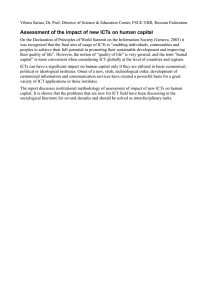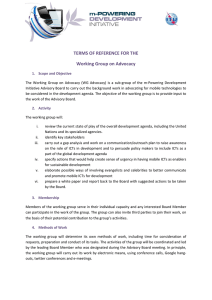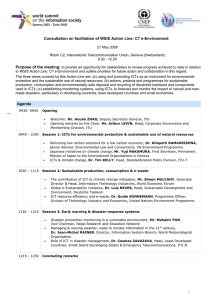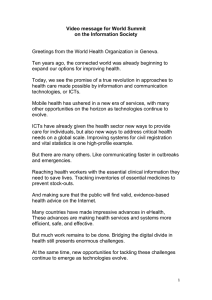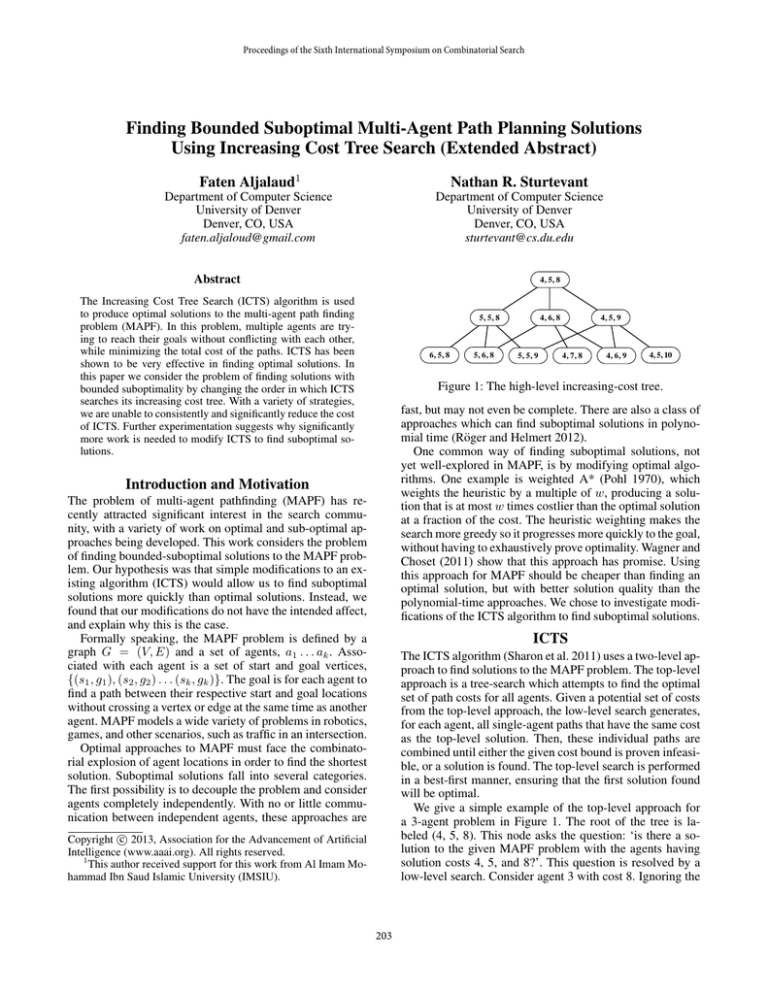
Proceedings of the Sixth International Symposium on Combinatorial Search
Finding Bounded Suboptimal Multi-Agent Path Planning Solutions
Using Increasing Cost Tree Search (Extended Abstract)
Faten Aljalaud1
Nathan R. Sturtevant
Department of Computer Science
University of Denver
Denver, CO, USA
faten.aljaloud@gmail.com
Department of Computer Science
University of Denver
Denver, CO, USA
sturtevant@cs.du.edu
Abstract
4, 5, 8
The Increasing Cost Tree Search (ICTS) algorithm is used
to produce optimal solutions to the multi-agent path finding
problem (MAPF). In this problem, multiple agents are trying to reach their goals without conflicting with each other,
while minimizing the total cost of the paths. ICTS has been
shown to be very effective in finding optimal solutions. In
this paper we consider the problem of finding solutions with
bounded suboptimality by changing the order in which ICTS
searches its increasing cost tree. With a variety of strategies,
we are unable to consistently and significantly reduce the cost
of ICTS. Further experimentation suggests why significantly
more work is needed to modify ICTS to find suboptimal solutions.
5, 5, 8
6, 5, 8
5, 6, 8
4, 6, 8
5, 5, 9
4, 5, 9
4, 7, 8
4, 6, 9
4, 5, 10
Figure 1: The high-level increasing-cost tree.
fast, but may not even be complete. There are also a class of
approaches which can find suboptimal solutions in polynomial time (Röger and Helmert 2012).
One common way of finding suboptimal solutions, not
yet well-explored in MAPF, is by modifying optimal algorithms. One example is weighted A* (Pohl 1970), which
weights the heuristic by a multiple of w, producing a solution that is at most w times costlier than the optimal solution
at a fraction of the cost. The heuristic weighting makes the
search more greedy so it progresses more quickly to the goal,
without having to exhaustively prove optimality. Wagner and
Choset (2011) show that this approach has promise. Using
this approach for MAPF should be cheaper than finding an
optimal solution, but with better solution quality than the
polynomial-time approaches. We chose to investigate modifications of the ICTS algorithm to find suboptimal solutions.
Introduction and Motivation
The problem of multi-agent pathfinding (MAPF) has recently attracted significant interest in the search community, with a variety of work on optimal and sub-optimal approaches being developed. This work considers the problem
of finding bounded-suboptimal solutions to the MAPF problem. Our hypothesis was that simple modifications to an existing algorithm (ICTS) would allow us to find suboptimal
solutions more quickly than optimal solutions. Instead, we
found that our modifications do not have the intended affect,
and explain why this is the case.
Formally speaking, the MAPF problem is defined by a
graph G = (V, E) and a set of agents, a1 . . . ak . Associated with each agent is a set of start and goal vertices,
{(s1 , g1 ), (s2 , g2 ) . . . (sk , gk )}. The goal is for each agent to
find a path between their respective start and goal locations
without crossing a vertex or edge at the same time as another
agent. MAPF models a wide variety of problems in robotics,
games, and other scenarios, such as traffic in an intersection.
Optimal approaches to MAPF must face the combinatorial explosion of agent locations in order to find the shortest
solution. Suboptimal solutions fall into several categories.
The first possibility is to decouple the problem and consider
agents completely independently. With no or little communication between independent agents, these approaches are
ICTS
The ICTS algorithm (Sharon et al. 2011) uses a two-level approach to find solutions to the MAPF problem. The top-level
approach is a tree-search which attempts to find the optimal
set of path costs for all agents. Given a potential set of costs
from the top-level approach, the low-level search generates,
for each agent, all single-agent paths that have the same cost
as the top-level solution. Then, these individual paths are
combined until either the given cost bound is proven infeasible, or a solution is found. The top-level search is performed
in a best-first manner, ensuring that the first solution found
will be optimal.
We give a simple example of the top-level approach for
a 3-agent problem in Figure 1. The root of the tree is labeled (4, 5, 8). This node asks the question: ‘is there a solution to the given MAPF problem with the agents having
solution costs 4, 5, and 8?’. This question is resolved by a
low-level search. Consider agent 3 with cost 8. Ignoring the
c 2013, Association for the Advancement of Artificial
Copyright Intelligence (www.aaai.org). All rights reserved.
1
This author received support for this work from Al Imam Mohammad Ibn Saud Islamic University (IMSIU).
203
ment. In other problems, however, it often is significantly
slower than ICTS.
These results suggest that either we are searching the tree
using the wrong policies, or that our approach of modifying
the top-level search strategy is not sufficient for finding suboptimal solutions quickly. While there may be better ways to
structure the low-level MDD search in order to more easily
find suboptimal solutions, we explain here why re-ordering
the top-level search does not work well on many problems.
There are three factors that contribute to the cost of ICTS.
The first cost is the cost of searching the high-level ICTS
tree. This tree grows exponentially if all costs for all agents
are considered. The second cost is the cost of building the
MDDs for each agent. The cost of a single MDD is O(N t),
so increasing the cost of a solution for an agent increases the
cost of building its MDD linearly. The final cost is the cost
of merging the MDDs together to find solutions. In general
this process can grow exponentially in the number of agents,
although in many cases infeasible cases can be quickly detected. The more solutions that are available for the agents,
the larger the merged MDDs.
The key relationship is that the deeper we search in the
ICT tree, the more expensive it becomes to find solutions.
Thus, if we jump deeper into the ICT tree looking for suboptimal solutions, we often incur more overhead searching
at nodes deeper in the tree than we save by avoiding nodes
shallower in the tree. While weighted A* gives room for a
greedy search to find the solution more quickly, allowing
more time in the MDDs actually makes more expensive to
merge agents’ paths and find feasible solutions.
Table 1: Suboptimal approaches to ICTS compared to the
original algorithm.
Algorithm
ICTS
AAC
Makespan
3*3 grid
# Solved
Time
43
6.2s
50
191ms
50
30ms
8*8 grid
# Solved Time
50
1.2s
42
4.7s
22
18.9s
other agents, all solutions with cost 8 for agent 3 are found
and stored in a Multi-Valued Decision Diagrams (MDD).
An MDD is an efficient way of storing the exponentiallygrowing number of paths in space linear in the size of the
map (N ) and time steps allowed for the solution (t), or
O(N t) space. Suppose that two agents MDDs both have the
same node at the same depth of the MDD, with no other
nodes at the same depth. Then, when comparing MDDs we
can see that no solution exist for both agents, as any solution
for either agent must pass through the same location at the
same time. This is part of a more general process that merges
MDDs together to form the set of all possible solutions.
We built an implementation of ICTS on top of Independence Detection (ID) (Standley 2010). ID starts a search
with each agent in a separate group, being considered independent of other agents. The optimal path for each group
is then found independently. If the solutions for any groups
conflict, these groups are merged and re-solved with ICTS.
The cost of search with ID is dominated by the largest group
of agents with conflicts.
Suboptimal ICTS
We approach the problem of finding suboptimal solution to
MAPF problems by modifying the top level of the ICTS
search. Instead of searching the top-level tree in a best-first
manner, we propose two alternate approaches; we have tried
other variants as well. These are:
All-Agent-Costs (AAC): ICTS only increments the cost of
a single agent from a parent to a child in the ICT. The AAC
approach increments the cost of all agents by one at each
subsequent node in the search tree.
Makespan (MS): The initial bound for each agent is set to
the maximum optimal single-agent path cost of all agents.
At each subsequent node, we increase the cost of all agents
by one. (The ICT grows linearly.)
Conclusion
In this short paper, we have proposed two approaches for
searching the top-level ICT tree with the aim of finding
bounded suboptimal solutions quickly. But, instead of finding solutions significantly more quickly, we find that the cost
of merging low-level ICT nodes outweighs the savings from
avoiding top-level ICT nodes. While this can be seen as a
negative result, this work provides a deeper understanding
of ICTS and provides a result that was not obvious when we
undertook this study. It is an open question how the problem topology influences these results and whether there is
other information that can be used to leverage ICTS to find
suboptimal solutions quickly.
Results and Analysis
References
First, we present the results of our suboptimal variants as
compared to the original ICTS algorithm in Table 1. The
results are shown in 3 by 3 grids using 6 agents and 8 by
8 grids using 10 agents. For each grid, we ran both optimal
ICTS and suboptimal approaches. There were 50 problems
chosen at random as the input data set. The running time of
each problem was limited to 5 minutes. The resulted running
time is the average for solved problems in the dataset. In
addition, the number of solved problems is shown. Similar
results were obtained in other problem variations.
These results show in general the approach works reasonably on small problems, but not on the larger ones. In problems that are very hard but still solvable for ICTS, the suboptimal approaches usually provides a significant improve-
Pohl, I. 1970. Heuristic search viewed as path finding in a graph.
Artificial Intelligence 1:193–204.
Röger, G., and Helmert, M. 2012. Non-optimal multi-agent
pathfinding is solved (since 1984). In Borrajo, D.; Felner, A.;
Korf, R. E.; Likhachev, M.; López, C. L.; Ruml, W.; and Sturtevant, N. R., eds., SOCS. AAAI Press.
Sharon, G.; Stern, R.; Goldenberg, M.; and Felner, A. 2011. The
increasing cost tree search for optimal multi-agent pathfinding. In
IJCAI, 662–667.
Standley, T. 2010. Finding optimal solutions to cooperative
pathfinding problems. In AAAI, 173–178.
Wagner, G., and Choset, H. 2011. M*: A complete multirobot
path planning algorithm with performance bounds. In IROS, 3260–
3267. IEEE.
204

